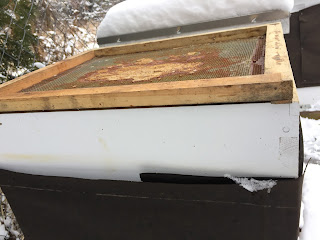Our first west MI winter winds and snow have arrived!! All the hives are wrapped in their winter garb of tar paper. I wrap to cover the seam in between the 2 deep boxes. I'm sure they probably have it propolized well, but just in case. A little extra wind break I figure. For me, essentials to overwintering are in no particular order;
1. Ventilation
2. Upper entrance
3. Food stores
4. Location
5. Keeping critters out.
See pics below for explanations on overwintering honeybees in West MI.
 |
| Honeybees on a milder day digging in to their sugar brick. Because most of my colonies are in single deeps going into winter, they are already at the "top" of the 2 deep brood boxes. The box on the bottom has 2-3 frames of drawn comb and frames of foundation for the bees to expand in the spring. I know it seems backwards, but it works. Because many are already up, I put sugar bricks in early if I see them near the top. If it's too cold for them to navigate over to another frame of honey, the brick will be right above them as a food source if needed. |
 |
| First snowfall this winter season in West MI, December 7. I love this yard because the Pine tress serve as an excellent natural wind break! |
 |
| I have an upper entrance hole in each hive so when the bottom entrances get covered with snow, there is still a way for the bees to exit. It also helps with ventilation. Again, notice the pines behind the hives, great natural windbreak. |
 |
| This just happened to be the best place for me to put bees in our backyard and the cage was already there. No skunks will be scratching at the front door of these hives this winter. It also acted as a barrier this summer so the bees always flew up first before heading out instead of straight across our yard. They rarely flew through the holes in the chain link. |
 |
| All hives in this yard in Hopkins, MI alive! We have many months to go though before pollen is available and spring greets us with warm breezes. Last year, the Silver Maple in our area bloomed on February 22 and bees were bringing in pollen!! So three and half to four months is all, that doesn't sound so long to have to wait :-) |
 |
| This is a dead out hive that has been getting robbed out. Wanted to show the screen board here with fiber board in it. It provides ventilation as the longer sides provide a seam for air to flow through. See picture below. The telescoping cover goes over this. I have bottom board, 2 deeps, queen excluder to set sugar brick on, shallow, winter screen and then telescoping cover. |
 |
| Dead out hive. Just wanted you to see screen board without the fiber board in it. The screen board, replaces the inner cover during the winter. Fiber board sits on top of the screen to help deflect warm air out to the sides where it is vented. See pic below. |
 |
| The open slit between shallow box and winter screen allows warm air produced by the hive to escape so condensation doesn't build up on underside of the telescoping cover and drip down on to the bees. The slits are on both long sides of the screen board. |
 |
| Baking more sugar bricks. I have made bricks many ways and there is no "one and only " way to do it. I use a variety of methods and the bees don't really seem to care. They take it down either way. A simple recipe is 10 pounds of sugar to 3/4 cup hot water, 1/4 vinegar and a teaspoon of honeybee healthy. I mix it in a 5 gallon bucket with paint mixer on the end of a drill. I dump it into pans, press it or roll it with a rolling pin so its compacted and bake it at 140-160 degrees F. for 4-5 hours. Place in hives when ready. |









No comments:
Post a Comment